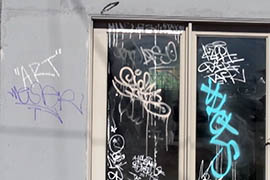Cronkite News has moved to a new home at cronkitenews.azpbs.org. Use this site to search archives from 2011 to May 2015. You can search the new site for current stories.
New law helps cities recoup costs of cleaning up when vandals caught
PHOENIX – To Dave Nash, Yuma’s public affairs coordinator, keeping the city free of graffiti is important for maintaining the quality of life and appealing to those who may want to do business there. But resources spent on abatement can be a drain on other municipal services.
“If it were a bad year we could be conceivably choosing between graffiti abatement and fixing a slide or graffiti abatement and watering a park or graffiti abatement and removing weeds off a ballfield,” Nash said.
That’s why he and other local officials are welcoming a new law that will allow cities and towns to recoup cleanup costs from vandals.
HB 2571, supported unanimously by lawmakers and signed into law by Gov. Jan Brewer, allows officials to add the cost of material and labor required for graffiti abatement to fines assessed in cases of criminal damage.
Rep. Juan Carlos Escamilla, D-San Luis, who sponsored the bill, said municipalities can wind up covering remaining costs when fines aren’t sufficient.
“As a former mayor myself, I lived firsthand the challenges that we faced when it came to graffiti,” he said.
The law also will allow municipalities to recover costs through community service.
“It’s a win-win for the cities,” Escamilla said.
Erynn Crowley, deputy director of the city of Phoenix’s Neighborhood Services Department, said the Graffiti Busters Program addresses about 75,000 sites of graffiti every year, something that takes time and money.
“We spend over $2 million a year removing graffiti in the city of Phoenix, and that’s just our department alone,” Crowley said.
“I think certainly knowing there may be a restitution cost is going to discourage some people from doing it,” she said.
Dave Wiebusch, legislative associate for the League of Arizona Cities and Towns, said the costs of a paint sprayer or delegating an employee to the abatement are examples of items that weren’t accounted for previously in penalizing vandals.
Yuma, the primary advocate for the bill, spent $117,645 on abatement during the 2012-2013 fiscal year, Wiebusch said.
“Statewide we’re talking millions of dollars,” he said.
According to Nash, any tool that Yuma and other municipalities can use to prevent having to choose between cleaning up graffiti and other projects will benefit everyone.
“It’s a little thing, but it’s going to make a difference because we’re going to recoup those costs and we can keep paying for the other maintenance that we have in our parks and recreation,” he said.







